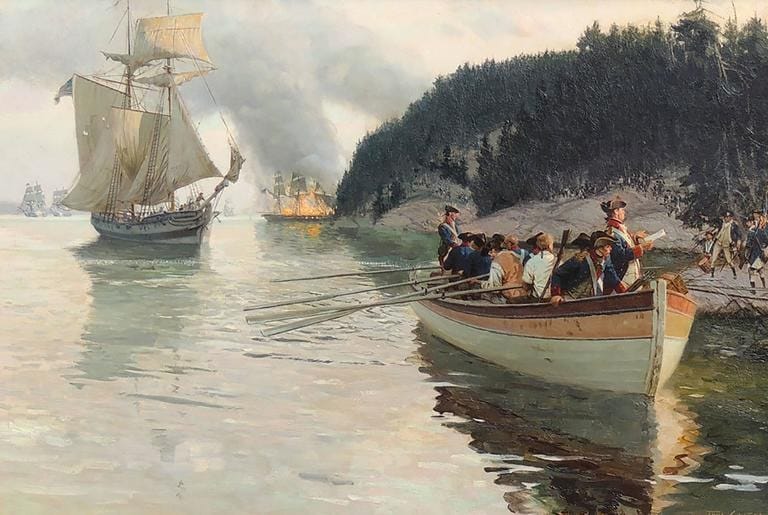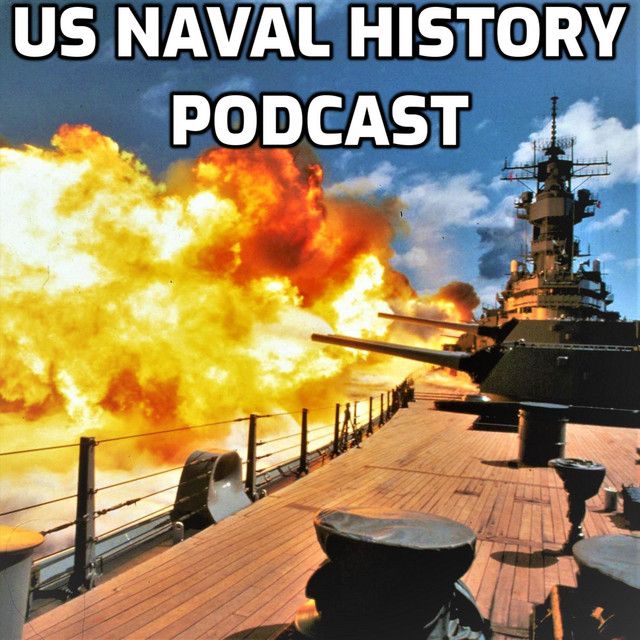Read the rest of the series: Part One | Part Two | Part Three | Part Five | Part Six | Part 7
Welcome back to the US Naval History Podcast, this is part 4 of the ignominious Penobscot Expedition. It's 1799, we are fighting the British in the Revolutionary War, and the American fleet of thirteen warships and 27 transport ships has arrived at Penobscot Bay. There, as expected, they find the British under General McLean in the beginning stages of building a fort on the Bragaduce Peninsula inside of Penobscot Bay. The American forces have made three attempted landings on the Bragaduce Peninsula. All three have been repulsed or pulled back, although the nearby smaller Banks' Island has been captured. You can listen to all of this as well as some background in the parts 1-3, but this part is where the real fighting starts, so feel free to start listening from here if all that other stuff doesn't matter to you.
We find our story on June 27, 1779, three days after the Americans first arrived with what can be pretty fairly called overwhelming force to knock out the British fort in Penobscot (in contemporary Maine) before it could be finished. From the top of Banks' Island the newly constructed firing position was taken over by sailors who opened fire on the British ships in Bragaduce Harbor. It turns out that the British ships' pull back overnight had not been far enough because the three British warships were getting hulled- that is hit in the hull- causing a few British casualties. The British pulled back a little farther under fire.
That afternoon, another American council of war between the ground and naval leaders of the Penobscot Expedition was held aboard the flagship Warren. Between the militia soldiers, artillerymen, and marines, a total of 1,157 men could be committed to the assault at Bragaduce. Everyone agreed that this was more than enough to overwhelm the British. Another landing would be attempted under cover of warship artillery on the Bragaduce Peninsula, this time starting at midnight and at a different location with the goal of catching the British by surprise.
The Assault
The assault did not start as planned. At midnight the order was given to embark the troops on the small boats for the assault. This took much longer than planned. Various problems led to there not being enough small boats. Finally, with all of the men loaded up, what was meant to be a mass landing embarked as a piecemeal wave towards Bradaduce.
Commodore Saltonstall, who lead the American naval component, ordered his warships to get as close to the beach and fire into the landing zone with grapeshot- that's basically a giant cannon shotgun used for anti-personnel attacks. This cleared out the underbrush and any British waiting for repel the assault. The first small boats scraped the rocky beach and the marines leaps ashore in the first wave below a bluff they would have to scramble up. There was one quick back and forth set of volleys at the beach line before the few British defenders pulled back and the Marines climbed up the bluff to create a perimeter for the rest of the landing. It was just after 5am.

Unfortunately for the British, the sergeant sent back to warn the bulk of the British force about the landing got lost in the foggy woods. The British army captain of the group of 70 or so men assigned to guard this section of beach had pulled back his men to wait for reinforcements against the superior Marine landing force. He began to worry when the reinforcements became later and later, and the next wave of American landing go closer and closer. Despite a less than auspicious beginning, the rest of the assault was unfolding beautifully for the Americans.
The Marines on the beach were climbing up a bluff in the dark fog. It was a steep slope and they were carrying rifles while slipping and sliding up the bluff, ripping shrubs and saplings out of the ground. The British made a stand just inside of the woods at the top of the steep bluff, but made a major tactical error by not firing down the step hill against the slowly climbing Marines, probably to protect themselves from American shipboard cannon fire. But it would have been worth it because in the words of one Marine captain, "We drove the Enemy from the ground which I think they might have kept till for ever, if they had chose to defend it." In other words, the Marines would have been picked off like fish in a barrel if the British had been willing to withstand some return cannon fire.
More and more Americans began to land and to push their way inland. There were sporadic skirmishes in the woods, but still the bulk of the British reinforcements had not arrived. No doubt many people were was wondering what happened to "that bloody sergeant." Soon, word reached General Wadsworth, who was the American general ashore who commanded the assault on the ground, that the bluff heights were secure. So far so good.


